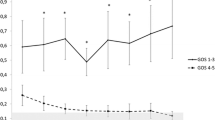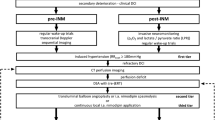Abstract
Pathophysiological findings of early brain injury in humans have not permitted conclusive determinations. We explored the essence of this phenomenon by taking intraoperative cortical specimens of Hunt-Kosnik grades IV~V (poor-grade) subarachnoid hemorrhages (SAH). From 2013 to 2017, we treated 39 consecutive poor-grade patients in 226 cases of aneurysmal SAH. Fourteen of the 39 patients agreed to this study following written informed consent. We took specimens from untouched areas prior to surgical intervention: cortex near the ruptured aneurysm for clipping, convexity cortex for cerebral ventricular drainage. Cortical specimens were stained with hematoxylin-eosin, anti-cleaved caspase-3, and anti-DNA/RNA damage staining. Positive signals were calculated in six random, high-power fields for quantitative assessment. Double immunofluorescence was done to evaluate neural damage. Chi-square analyses were carried out to assess the correlation between the Glasgow Outcome Scale at 90 days after the ictus and the number of positive cells. Cortical specimens were taken at 12.7 ± 7.00 h after the first ictus. All 14 cases showed dense nuclei, with the appearance of acidic and shrunken cytoplasms. Diffuse positivity of anti-cleaved caspase-3 and anti-DNA/RNA damage was detected. Cleaved caspase-3 was detected in 68% of neurons, and DNA/RNA damage was detected in 64% of neurons. Positive reactions of both antibodies indicated poor outcome. With poor-grade cases, irreversible ischemic, apoptotic, and oxidative changes were detected in the cerebral cortex within several hours after the ictus. Those changes occurred far from the aneurysm. Our findings suggest that a revolution is needed in the treatment strategy for poor-grade SAH.



Similar content being viewed by others
References
Connolly ES Jr, Rabinstein AA, Carhuapoma JR, Derdeyn CP, Dion J, Higashida RT, et al. Guidelines for the management of aneurysmal subarachnoid hemorrhage: a guideline for healthcare professionals from the American Heart Association/american Stroke Association. Stroke. 2012;43(6):1711–37. https://doi.org/10.1161/STR.0b013e3182587839.
Steiner T, Juvela S, Unterberg A, Jung C, Forsting M, Rinkel G, et al. European stroke organization guidelines for the management of intracranial aneurysms and subarachnoid haemorrhage. Cerebrovasc Dis. 2013;35(2):93–112. https://doi.org/10.1159/000346087.
Macdonald RL. Delayed neurological deterioration after subarachnoid haemorrhage. Nat Rev Neurol. 2014;10(1):44–58. https://doi.org/10.1038/nrneurol.2013.246.
Shimamura N, Naraoka M, Katagai T, Katayama K, Kakuta K, Matsuda N, et al. Analysis of factors that influence long-term independent living for elderly subarachnoid hemorrhage patients. World Neurosurg. 2016;90:504–10. https://doi.org/10.1016/j.wneu.2016.03.057.
Grote E, Hassler W. The critical first minutes after subarachnoid hemorrhage. Neurosurgery. 1988;22(4):654–61. https://doi.org/10.1227/00006123-198804000-00006.
Busch E, Beaulieu C, de Crespigny A, Moseley ME. Diffusion MR imaging during acute subarachnoid hemorrhage in rats. Stroke. 1998;29(10):2155–61.
Cahill J, Calvert JW, Zhang JH. Mechanisms of early brain injury after subarachnoid hemorrhage. J Cereb Blood Flow Metab. 2006;26(11):1341–53. https://doi.org/10.1038/sj.jcbfm.9600283.
Kusaka G, Ishikawa M, Nanda A, Granger DN, Zhang JH. Signaling pathways for early brain injury after subarachnoid hemorrhage. J Cereb Blood Flow Metab. 2004;24(8):916–25. https://doi.org/10.1097/01.WCB.0000125886.48838.7E.
Hartings JA, York J, Carroll CP, Hinzman JM, Mahoney E, Krueger B, et al. Subarachnoid blood acutely induces spreading depolarizations and early cortical infarction. Brain. 2017;140(10):2673–90. https://doi.org/10.1093/brain/awx214.
Nakano F, Liu L, Kawakita F, Kanamaru H, Nakatsuka Y, Nishikawa H, et al. Morphological characteristics of neuronal death after experimental subarachnoid hemorrhage in mice using double immunoenzymatic technique. J Histochem Cytochem. 2019;67(12):919–30. https://doi.org/10.1369/0022155419878181.
Satomi J, Hadeishi H, Yoshida Y, Suzuki A, Nagahiro S. Histopathological findings in brains of patients who died in the acute stage of poor-grade subarachnoid hemorrhage. Neurol Med Chir (Tokyo). 2016;56(12):766–70. https://doi.org/10.2176/nmc.oa.2016-0061.
Smith B. Cerebral pathology in subarachnoid haemorrhage. J Neurol Neurosurg Psychiatry. 1963;26:535–9. https://doi.org/10.1136/jnnp.26.6.535.
Nau R, Haase S, Bunkowski S, Bruck W. Neuronal apoptosis in the dentate gyrus in humans with subarachnoid hemorrhage and cerebral hypoxia. Brain Pathol. 2002;12(3):329–36.
Zubkov AY, Ogihara K, Bernanke DH, Parent AD, Zhang J. Apoptosis of endothelial cells in vessels affected by cerebral vasospasm. Surg Neurol. 2000;53(3):260–6. https://doi.org/10.1016/s0090-3019(99)00187-1.
de Oliveira Manoel AL, Goffi A, Marotta TR, Schweizer TA, Abrahamson S, Macdonald RL. The critical care management of poor-grade subarachnoid haemorrhage. Crit Care. 2016;20:21. https://doi.org/10.1186/s13054-016-1193-9.
Sabri M, Kawashima A, Ai J, Macdonald RL. Neuronal and astrocytic apoptosis after subarachnoid hemorrhage: a possible cause for poor prognosis. Brain Res. 2008;1238:163–71. https://doi.org/10.1016/j.brainres.2008.08.031.
Acknowledgments
We thank Markus Inglin (University of Basel) for his editorial assistance.
Author information
Authors and Affiliations
Corresponding author
Ethics declarations
Conflict of Interest
The authors declare that they have no conflict of interest.
Ethical Approval
All procedures performed in studies involving human participants were in accordance with the ethical standards of the institutional research committee and with the 1964 Helsinki declaration and its later amendments or comparable ethical standards.
Additional information
Publisher’s Note
Springer Nature remains neutral with regard to jurisdictional claims in published maps and institutional affiliations.
Rights and permissions
About this article
Cite this article
Shimamura, N., Fumoto, T., Naraoka, M. et al. Irreversible Neuronal Damage Begins Just After Aneurysm Rupture in Poor-Grade Subarachnoid Hemorrhage Patients. Transl. Stroke Res. 12, 785–790 (2021). https://doi.org/10.1007/s12975-020-00875-0
Received:
Revised:
Accepted:
Published:
Issue Date:
DOI: https://doi.org/10.1007/s12975-020-00875-0




